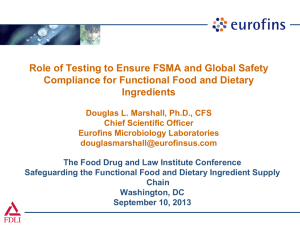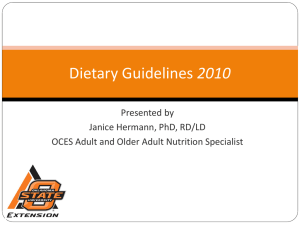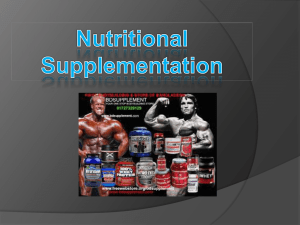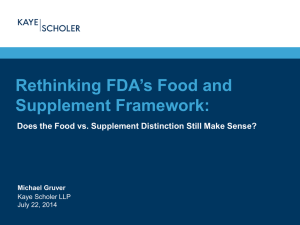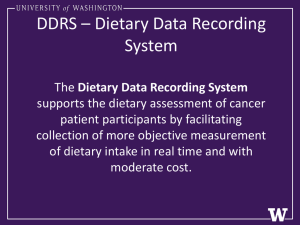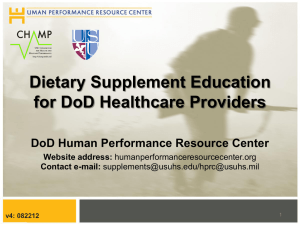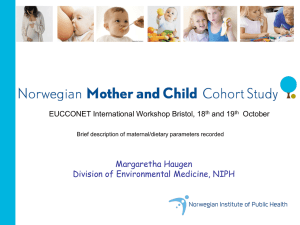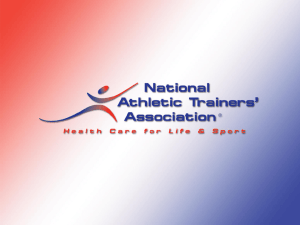Prescription drugs
advertisement
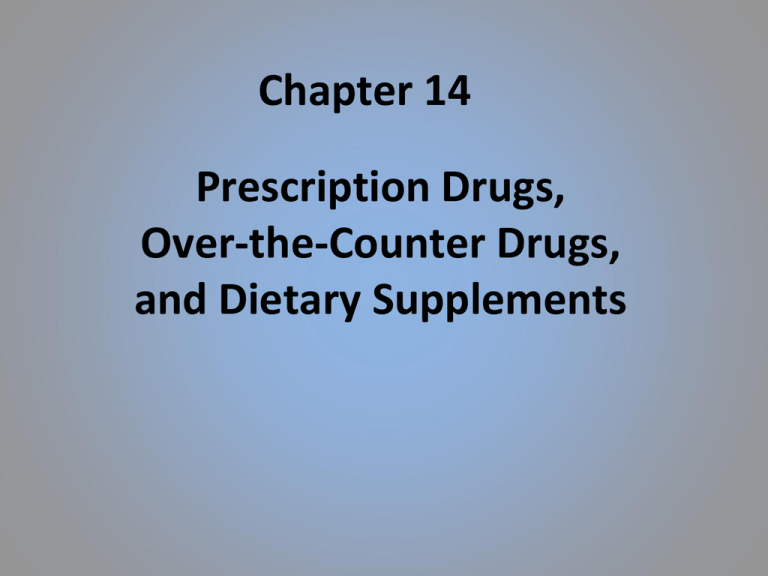
Chapter 14 Prescription Drugs, Over-the-Counter Drugs, and Dietary Supplements Categories of Medicinal Products Three categories of medicinal substances are available for purchase: • prescription drugs • over-the-counter (OTC) drugs • dietary supplements Categories of Medicinal Products The U.S. Food and Drug Administration (FDA) sets standards of safety, effectiveness, and honesty in labeling for prescription drugs and OTC drugs. Dietary supplements are not regulated as drugs. Cosmetics are also regulated by the FDA. “articles intended to be rubbed, poured, sprinkled, or sprayed on, introduced into, or otherwise applied to the human body...for cleansing, beautifying, promoting attractiveness, or altering the appearance" What is a drug? Drug: A chemical substance which, when taken into the body, alters the structure or functioning of the body in some way. Problems with this definition? …excluding those nutrients considered to be related to normal functioning. (whether the substance in question has been intended to be used primarily as a way of inducing a bodily or psychological change; p. 5) Is toothpaste a drug? Is deodorant a drug? Is shampoo a drug? Is skin moisturizer a drug? Scents—Drugs or Not? (does it make sense?) Perfumes? Room deodorizers? Aromatherapy? How the Regulation of Prescription and OTC Drugs Began No regulation prior to 1906; “snake oil” salesmen abounded 1906 Pure Food and Drug Act ensured purity and consistency of drugs active ingredients must be identified on label 1938 Food Drug and Cosmetic Act ingredients in drugs and cosmetics must be proven safe basis of modern food and drug regulations 1962 Kefauver-Harris Amendment drug must be proven safe and effective _________is the basis for all present-day U.S. food and drug laws. A. The Pure Food and Drug Act of 1906 B. The Dietary Health and Education Act of 1994 C. The Federal Food, Drug, and Cosmetic Act of 1938 D. The Kefauver-Harris Amendment of 1962 E. The Dietary Supplement Health and Education Act of 1994 Procedures for Approving Prescription and OTC Drugs 1. animal studies determine safety limits and relative toxicity 2. clinical trials a. healthy human volunteers Phase 1: establish drug safety b. patients Phase 2: establish effectiveness for therapeutic use Phase 3: identify optimal doses and dosing regimen; identify side effects Marketing of drug Patent clock begins to run safety therapeutic effectiveness LD 50, birth defects dosing regimen, side effects, usage—final tweaking long-term toxicity (or more) A serious problem in the development and testing of many drugs is that interactions with other drugs are not tested and may be unpredictable. There may also be unanticipated long-term effects. In Phase 1 clinical trials, __________. A. certain pharmacological questions are answered B. clinical samples are not involved C. safe dosage levels are determined D. drug effectiveness is not considered E. all of the above Procedures for Approving Prescription Drugs Very few new compounds are eventually approved by the FDA for marketing as new prescription drugs. The process often takes several years. Patent clock (20 years) begins to run when Phase 1 clinical trials begin. drug companies must recover research costs may introduce “new” drugs with minor differences to obtain a new patent (e.g. time-release version) may obtain approval to market drug OTC (e.g. Tylenol, Benadryl, Claritin) Table 14.2 Procedures for Approving OTC Drugs Since 1962, all OTC drugs have been required by the FDA to be Generally Recognized As Safe (GRAS) Effective (GRAE) Honestly Labeled (GRAHL) Approval of OTC drugs must follow the NDA process or, more commonly, conform to existing drug monographs. Table 14.3 Are FDA-Approved Drugs Safe? Prescription and OTC drugs are FDA-approved for use when taken in the recommended dosages and under the recommended circumstances, their misuse can result in medical emergencies and fatalities. Prescription drug misuse, whether intentional or unintentional (prescription errors), is a growing public health problem as the number of available medications increases. There have been several recent instances of drugs with similar names being incorrectly dispensed Are FDA-Approved Drugs Safe? ER visits involving prescription drugs far fewer than those involving illegal drugs Prescription drugs are often the choice for suicide attempts Most ER visits involving prescription drugs are for polydrug use, usually alcohol (e.g. benzodiazepines and other depressants; OxyContin and other opiates) Doctor-shopping, lax medical oversight of multipleprescription users (often the elderly) Which of the following best characterizes the FDA’s approach to approving drugs for the market? A. speed B. empathy C. caution (safety) D. need for the drug E. likely profitability of the drug Major OTC Analgesic Drugs OTC analgesic drugs acetylsalicylic acid (aspirin), acetaminophen (e.g. Tylenol) ibuprofen (e.g. Advil, Motrin) naproxen (e.g. Aleve) Major OTC Analgesic Drugs aspirin, ibuprofen and naproxen are antiinflammatory (non-steroidal anti-inflammatory drugs; NSAIDs) acetaminophen is not anti-inflammatory aspirin and acetaminophen are both anti-pyretic (fever-reducing) long duration of effect makes naproxen effect for relief of menstrual cramps NSAIDs may interact with, and reduce the effectiveness of, SSRI antidepressants. Major OTC Analgesic Drugs Hazards include: aspirin: gastrointestinal irritation, bleeding acetaminophen: bleeding, liver and kidney damage especially troublesome with alcohol consumption potentially lethal ibuprofen: kidney damage or failure naproxen: gastrointestinal irritation Analgesic Acetylsalicylic Acid (aspirin) Acetaminophen (Tylenol) Ibuprofen (Advil, Motren) Naproxen Sodium (Aleve) AntiInflammatory Anti-pyretic Other Major Classes of OTC Drugs OTC sleep aids and cough-and-cold remedies are notable for their popularity and their potential for misuse. sleep aids with an active ingredient of either diphenhydramine (e.g. Benadryl) or doxylamine succinate (e.g. Unisom). these antihistamines are depressants that are typically components of “P.M.” versions of cold medications Other Major Classes of OTC Drugs OTC sleep aids and cough-and-cold remedies are notable for their popularity and their potential for misuse. antihistamines + alcohol additive alcohol content increases abuse potential pseudoephedrine used to make crystal methamphetamine although still OTC, sales are now monitored dextromethorphan is a continuing drug abuse problem (so-called “robo-tripping,” after “Robitussin”) The Pharmaceutical Industry Today Highly competitive market advertising in mass media diversification of products protection from generics The Pharmaceutical Industry Today Pressure to reduce prices high cost of drug research uninsured and underinsured patients maintaining adequate supplies problems regulating internet trafficking of prescription medications copycats masquerade as brand-name drug often of foreign origin manufacturing unsupervised problems of accuracy and purity What is a Dietary Supplement? 1994 Dietary Supplement Health and Education Act (DSHEA) A dietary supplement is “a product taken by mouth that contains a ‘dietary ingredient’ intended to supplement the diet. a vitamin a mineral an herb or other botanical an amino acid a dietary substance for use by man to supplement the diet by increasing the total dietary intake (e.g., enzymes or tissues from organs or glands) a concentrate, metabolite, constituent or extract. Dietary Supplements A large number of dietary supplements are available to the public. Unlike OTC preparations, dietary supplements are not evaluated by the FDA for safety or efficacy. This lack of regulation should not be construed to tacit approval of either their use or safety. They may or may not be safe or effective and may interact with other drugs. Therefore, considerable caution should be exercised when using them. Which of the following is a dietary supplement? A. an analgesic B. a weight-loss aid C. an herbal formula to boost testosterone D. a cough and cold remedy Dietary Supplements Dietary supplements are considered foods, not drugs. Under DSHEA, a firm is responsible for determining that the dietary supplements it manufactures or distributes are safe and that any representations or claims made about them are substantiated by adequate evidence to show that they are not false or misleading. Pre-market review for safety data and other information is required. Manufacturers need to register with the FDA pursuant to the Bioterrorism Act Dietary Supplements What must appear on a label of a dietary supplement? a descriptive name of the product stating that it is a "supplement" the name and place of business of the manufacturer, packer, or distributor a complete list of ingredients (active and inactive) the net contents of the product Dietary Supplements Claims of medical benefits for supplements are often exaggerated and are difficult to verify because wellcontrolled scientific studies of their effectiveness are either nonexistent or incomplete. Clearly, more scientific studies should be conducted to evaluate these supplements. (Why AREN’T there more studies?) Dietary Supplements The FDA monitors the marketplace for illegal products (products that may be unsafe or make false or misleading claims) and obtains information from inspections of dietary supplement manufacturers and distributors the Internet consumer and trade complaints occasional laboratory analyses of selected products adverse events associated with the use of supplements that are reported to the agency. Dietary Supplements A product cannot make claims to be a treatment, prevention or cure for a specific disease or condition (only substances classified and regulated as drugs may do that). Manufacturers MAY make health claims (links between a food substance and disease or a health-related condition) structure/function claims (intended benefits of using the product) nutrient content claims (amount of a nutrient or dietary substance in a product) Dietary Supplements Disclaimers are often provided to qualify claims “This statement has not been evaluated by the FDA. This product is not intended to diagnose, treat, cure, or prevent any disease” Claims of medical benefits for supplements are often exaggerated and are difficult to verify because wellcontrolled scientific studies of their effectiveness are either nonexistent or incomplete. Clearly, more scientific studies should be conducted to evaluate these supplements. (Why AREN’T there more studies?) Dietary Supplements Cautionary notes: active chemical constituents of dietary supplements need not be specifically identified doses of active chemicals may vary by lot; actual dose will therefore vary those taking supplements may fall victim to the “more must be better” thinking; e.g. pyridoxine (vitamin B6) potential side effects need not be listed on the label potential drug interactions need not be listed http://www.forcefactor.com/?fb_lgid=4755&fb_ lpid=13766&fb_itid=12932&pid=180&nid=25 http://healthyconsumerliving.com/prm/
